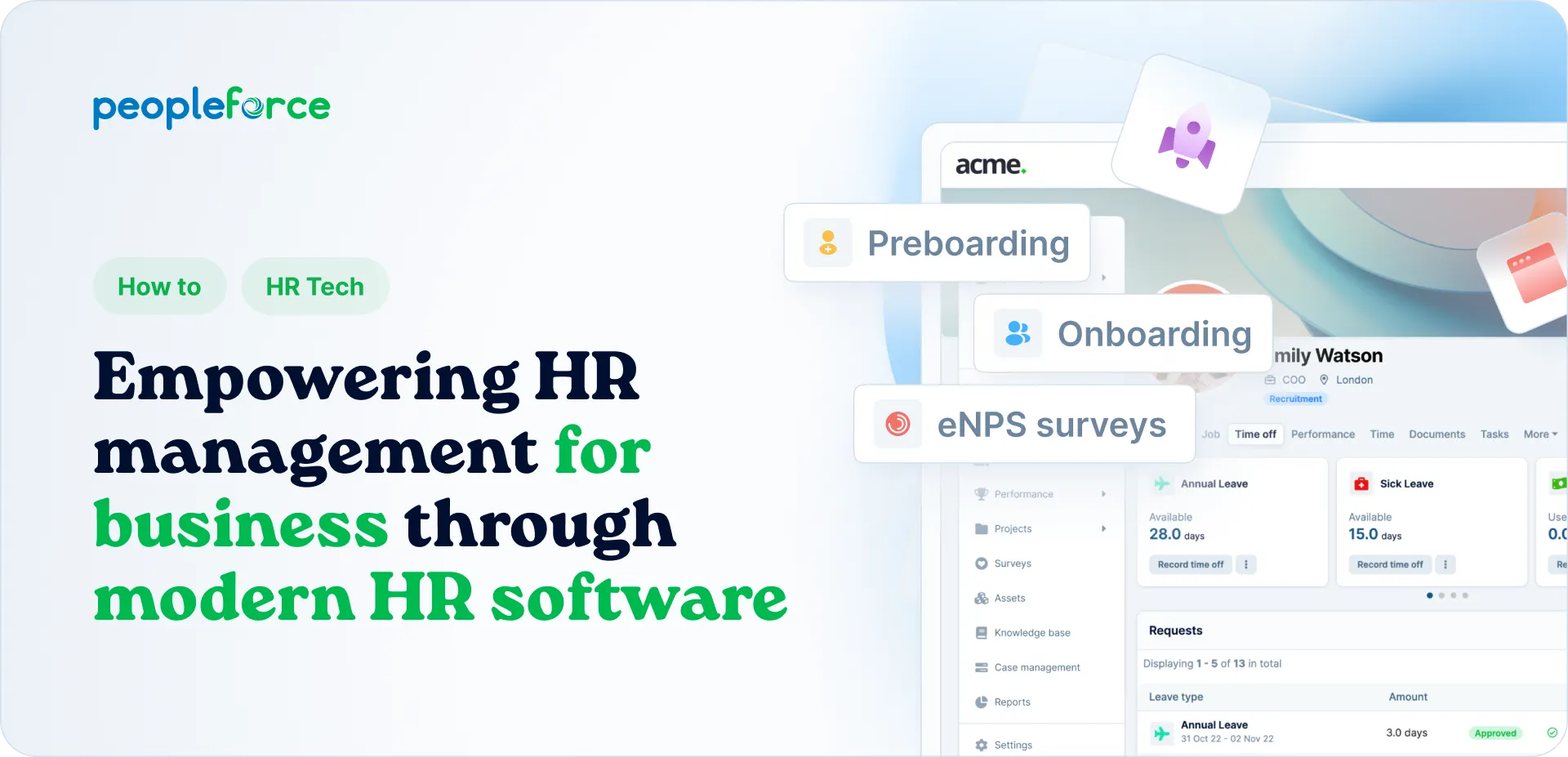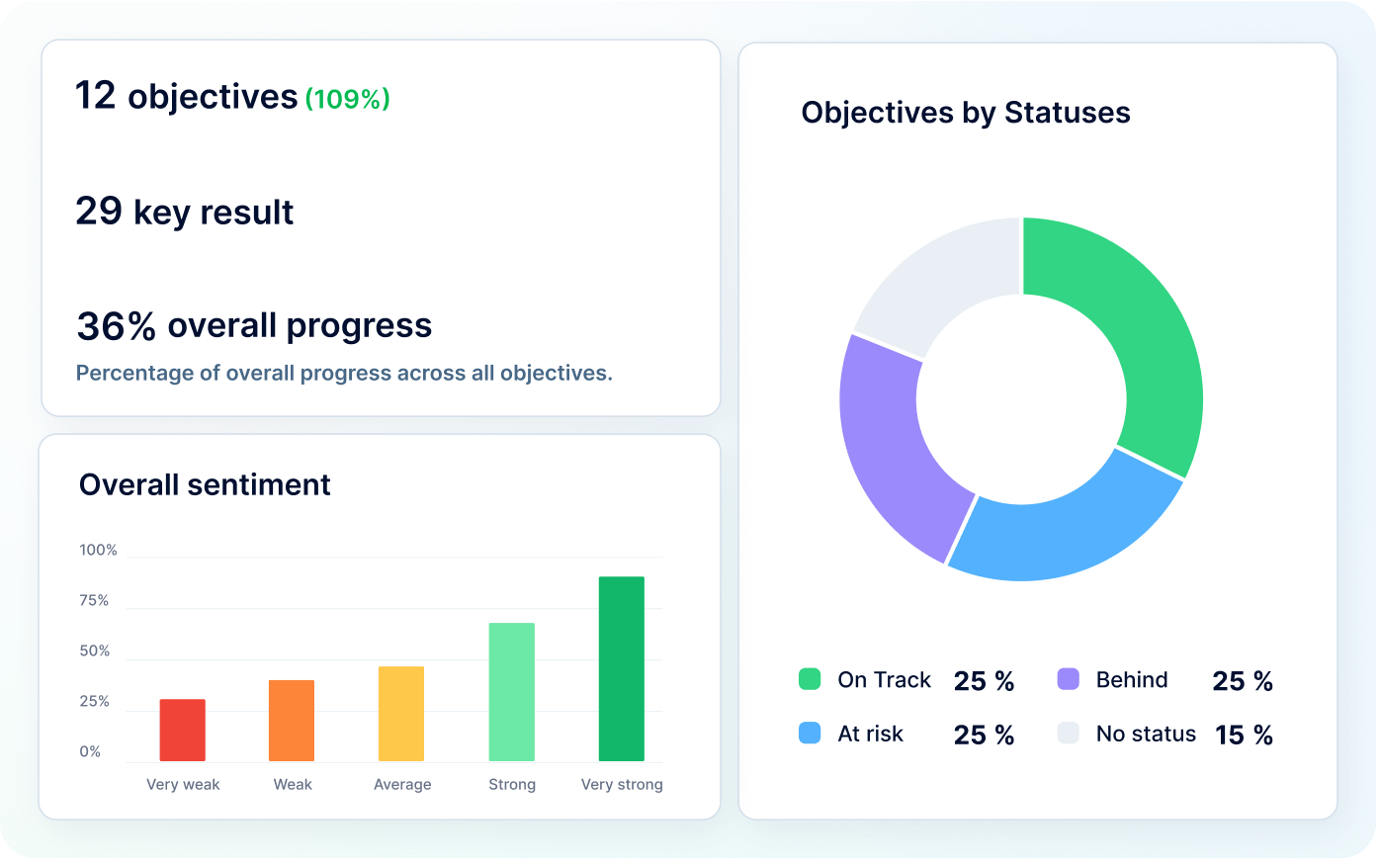
Empowering HR management for business through modern HR software
Employee retention is one of the top five priorities for human resource managers. Struggling to keep your talent, let alone empower employees to perform their best? If so, hi, you’re in the right place.
We know that HR management and team leads don't have it easy. That's why we wanted to talk about the crucial role of human resource management software in organizations. These solutions can take a weight off your shoulders by automating up to a whole day of the work week you can use to focus on matters that need your attention most.
Read on to discover the range of capabilities of human resource management systems.
Current challenges for HR management in business
Research shows that three out of four employees seek manager support, while leaders juggle 51% more workload than they can handle. That causes more than 70% of HR leaders to feel overwhelmed and unequipped to empower employees.
It’s not easy to improve employee empowerment, motivation and productivity. Neither to hire new talent, especially considering the money shortages that concern many companies due to inflation.
Some sources say the average cost per hire is $4,700, while others estimate the total to be up to four times the position's salary. Imagine the costs of making the wrong hiring decisions or insufficient focus on onboarding, which can cause the employee to leave within the first 90 days of work.
Opportunities provided by Human Resource Management Systems
HR tech is in the top five priorities for managers in 2024. No wonder – to overcome the current challenges, you need a powerful HR management system that will serve each one of your organization's employees – from leaders and HR professionals to teams and individual workers. We've got just the solution – an HRM system.
Here are the tools modern HRM systems should include:
- A place for centralizing all HR tasks, employee data and workflows
- An in-built applicant tracking system
- A solution to monitor your company's success with OKR goals and KPIs
- A method of measuring employee satisfaction and engagement with surveys
- A tool for tracking working hours and managing workloads better
- A customizable helpdesk where employees can submit their questions and issues
Successful application use cases of HR platforms
If you want to see the benefits from above and create a team of motivated employees, you need an HR management platform that can handle all your needs. Read on to explore how such tools can aid you on your way to your own professional development and employee empowerment.
Streamlined preboarding and onboarding processes
Although synonyms at first glance, these two terms mean something slightly different. Preboarding is the brief stage before onboarding when new employees get acquainted with their future work environment – after getting hired and before coming into work. It's also when an HR manager collects information about the new hire, gathers additional documents etc.
A unified HR management system helps you avoid the piles of paperwork and getting lost in emails. You can set up a questionnaire for newcomers to fill in all the necessary information about themselves. Then, the platform can automatically add the data to the employee's profile in your directory.
You can personalize the form to ask about anything you may need to know:
- Personal information, like hobbies or interests
- Workspace and equipment preferences
- Additional documents or certificates
- Emergency contacts
- Illnesses, allergies etc.
Preboarding flows provided by such systems help to prepare new talent before their first day, making them immediately connected, feel a part of the team and know their responsibilities.
The day the employee comes into work is when the onboarding stage starts. Forbes experts say this process is “essential if you’d like to retain employees, reduce turnover and maximize productivity.”
Before you ask – an HRM system has your back with this too.
Its streamlined workflow helps you provide employees with a smooth and pleasant transition, maximizing newcomer engagement. With the flexible employee onboarding software, you can create any number of programs for all your different departments – each with its own specified deadlines.
A good system should be highly customizable so you can include tasks, text, images, video instructions and any other attachments to keep employees engaged – which brings us to our next point.
Improved employee engagement and retention
Employee engagement is still low, and boosting it remains one of the top concerns for HR management teams.
One of the best ways to improve employee empowerment, motivation and retention is to give them a voice and make sure it's heard. HR platforms do just that. Here's how:
- Feedback collection, done regularly and systematically
- Overall sentiment score
- eNPS surveys for tracking staff satisfaction levels and showing you how and where to improve
- Trends and dynamics view based on employee feedback results
- Pre-built templates and questions that you can freely customize
- Identification of key drivers that affect staff engagement
- Automated, flexible reminders and survey invitations
- Response rates insights and segmented statistics
- Easy export for presenting the results to managers
- Comments and opinions tracking for more personal-level insights
When you create a workplace where employees feel empowered and their issues are resolved swiftly, you instantly boost staff loyalty and reduce churn.
Enhanced data-driven decision-making
Full control over your company means knowing when to make decisions that drive you forward. For that, you need constant access to HR analytics and reporting.
Here are some insights HR tools can provide you with:
- Headcount reporting by divisions or locations
- Detailed capacity reports for accurate project resourcing
- Leave balance reporting, including sick days or leave without pay
- Employee turnover with filtering by location, department, position and employment type
- KPI and OKR reporting facilitating smart goal setting and progress tracking
- Performance review data can be broken down by team or individual members and compared against each other
- Job cycle funnel for pinpointing when candidates typically drop out and improving your recruiting efforts
- Custom reports
- Employee satisfaction and eNPS surveys
Speaking of staff job satisfaction, we know it isn’t easy for employees to talk to managers about these issues. That's why we included a Safe Speak feature for your team to express themselves freely via 100% anonymous direct reports. This safe space helps to address difficult issues and promote a healthy, transparent company culture.
The Safe Space functionality complies with the EU Whistleblower Directive and is sharable with external parties, e.g., candidates applying for your open roles.
This feature ensures that you will make decisions based not only on numbers but also on compassion. It's a way of creating a fair environment of empowered employees where no voice goes unheard.
Improved performance management
As mentioned, your HR platform should automatically track your KPIs (key performance indicators) and OKRs (objectives and key results). This data lets you align the efforts of each team member with your company goals. Over 86% of leaders struggle to make clear career development paths. PeopleForce can be a valuable resource to overcome that and give more meaning and purpose to the employee journey.
Following the progress of each department means you never veer off track. You can create customizable goal trees with checklists for each team member and set up processes with deadlines. Then, sit back and let the platform ensure your organization stays on the growth path.
Performance tools give you even more possibilities for employee performance management. For example, you can create automated 360-degree surveys to collect constructive, honest feedback about team members from multiple perspectives. Treat them as a learning opportunity and a method of improving your leadership skills by gathering upward feedback from staff.
Be sure to sum it all up with productive one-on-ones. Create a checklist of talking points and action items that get automatically pushed to the next meeting if unfinished. That way, you never overlook anything in need of attention.
Increased agility and adaptability
Tie it all together with the HRIS system to achieve maximum automation, productivity and flexibility. It helps you act faster because you can say goodbye to scattered documents and disconnected pieces of data. The HRIS system should centralize everything, including:
- Salary information
- Time off tracking and requests
- Onboarding and offboarding steps
- Workflows for processes of any complexity level
- A knowledge base where employees can find any information they need
Feel empowered knowing your company adapts to any internal and external changes easily. HRIS systems help you respond to issues quickly and wisely by keeping you informed about your staff numbers, workloads, and well-being.
Modern HR management systems integrate with other tools you're already using to make work run more efficiently. For example, our HR platform, PeopleForce, integrates with:
- Slack
- Microsoft
- Telegram
- Zoom
- Zapier
Benefits for Human Resource managers
Take a moment to consider the many advantages that come with HR systems like ours:
- HR systems can handle 70% of all your routine HR and recruiting tasks.
- Our customers say it frees up about 20 hours of their time every week.
- All you need is one person and more or less two weeks to set it up and running (depending on your company size).
- Users report a 25% increase in work speed and productivity with our system, which gives you a whole extra work day.
- When signing up for PeopleForce, you join over 800 companies that have already trusted us and loved the experience.
Harnessing the power of Human Resources in management
Progressive HR software can make your life easier by:
- Streamlining preboarding and onboarding
- Improving employee engagement and retention
- Enhancing data-driven decision-making
- Improving performance management
- Increasing agility and adaptability
The all-in-one HR management system is your key to empowered employees and a resilient team that can handle business and people challenges.
Our HR platform covers all the use cases we mentioned. Book your free demo and enjoy 14 days free to explore the wide range of PeopleForce HR capabilities.
Get started with PeopleForce today
Automate your HR routine to create a high performance culture in your company. PeopleForce is your best HRM alternative to stay business driven but people focused.

Recent articles
Pre-boarding: the crucial step of a positive employee experience
Pre-boarding involves an intermediate stage between job acceptance and an employee's official start date.
How to organize matrix teams with an HR platform
If you are looking for HRM functionality, PeopleForce is the platform you need to comprehensively support matrix structures
10 HR workflows that you should automate
Let's consider why automated workflows are necessary in 2023 and where the demand for avoiding human error in task execution comes from.

